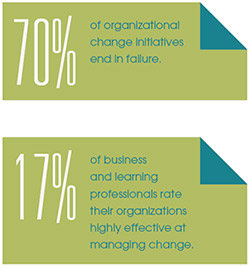
How High-Performance Organizations Avoid the Crash-and-Burn of Change
Dismal outcomes for change initiatives aren't new. They've been the way of the business world for years, affecting nearly three of every four organizational transitions.
-Change Agents: The Role of Organizational Learning in Change Management, ATD/i4cp
Have you noticed that the thing about change is that it never changes? It remains stuck at the top of business leaders' agendas year after year. "We need to manage change better," executives acknowledge. But few seem to make much headway.
Change Agents: The Role of Organizational Learning in Change, a recent collaborative study by i4cp and ATD (Association for Talent Development, formerly ASTD), reports that only 17% of leaders believe their organizations are highly effective at managing change.
 Well, there you go. The latest research confirmed--again--that most of us remain dismally rotten changers. But wait, there's more: Many of the 765 business and learning leaders surveyed for the study confirmed that their companies are experiencing more changes every year. And those shifts are coming faster and more unpredictably--so more opportunities for us to fail will be along soon.
Well, there you go. The latest research confirmed--again--that most of us remain dismally rotten changers. But wait, there's more: Many of the 765 business and learning leaders surveyed for the study confirmed that their companies are experiencing more changes every year. And those shifts are coming faster and more unpredictably--so more opportunities for us to fail will be along soon.
But we're not totally up you-know-what creek with no paddle. The study found some positives--for instance, despite often dicey outcomes, executives lead their organizations into the roiling seas of change for good reasons. The leading change driver, according to 51% of those surveyed, is the goal of increasing sales and revenue.
Companies also pin their hopes on change initiatives to meet and beat the competition, launch new products, fulfill unmet customer needs, and rise to the challenges of market shifts, expanding globalization, and evolving technologies. In other words, leaders undertake change to fuel greater business success. Further, study results confirmed that effectiveness in managing change is strongly related to high market performance. Now that's positive motivation to handle change better.
Even with powerful incentives driving change, leaders still need sound strategies and strong execution support to avoid the 70% crash-and-burn rate that befalls most organizational transitions. The study found that the presence of a designated team to spearhead change management is correlated with change effectiveness. However, it also found that most organizations (more than six of 10) don't have change teams.
Instead (and in addition to), leaders are turning to organizational learning functions to deliver relevant, innovative, and dynamic learning opportunities designed to give managers and employees alike the skills they need to take on change more comfortably and capably. And in high-performance organizations (based on revenue growth, profitability, market share, and customer satisfaction over time), change-management effectiveness (leading to better business performance) is strengthened by these differentiating traits:
- Change-management training rises...and ripples outward. Learning practices in high-performance organizations (HPOs) extend training in change management to senior leaders and to all employees at a rate nearly 1.5x that of lower-performers.
- Training quality is a compelling commitment. In high-performance organizations, learning professionals are almost 1.5x more likely to enlist internal subject matter experts and to apply research on HPO practices to ensure they are delivering top-quality change-management training. Further, HPOs seek (and apply) insights from individuals and companies experienced in the specific types of change they wish to accomplish at 2x the rate of lower-performers.
- Funding for change-management training is a priority. At every stage of learning related to change--planning, design, and delivery--lower-performing companies are 1.5x more likely than HPOs to blame inadequate financial support for impeding their effectiveness. In fact, at a rate 2.2x that of HPOs, those same lower-performers admit that, in their organizations, funding is consistently inadequate for them to provide training needed to support change initiatives.
- Action doesn't stop when a change is made. In high-performance organizations, business and learning leaders understand that sustaining progress requires ongoing effort. HPOs are nearly 2x more likely than lower-performers to provide initiative-specific refresher training after a change has been completed; they're more than 2.5x more likely to implement a post-change measurement strategy for each initiative the organization undertakes.
For more insights into i4cp/ATD research in change management, visit i4cp.com to download a complimentary white paper based on Change Agents: The Role of Organizational Learning in Change Management. The full report is available for purchase from the ATD Store.
